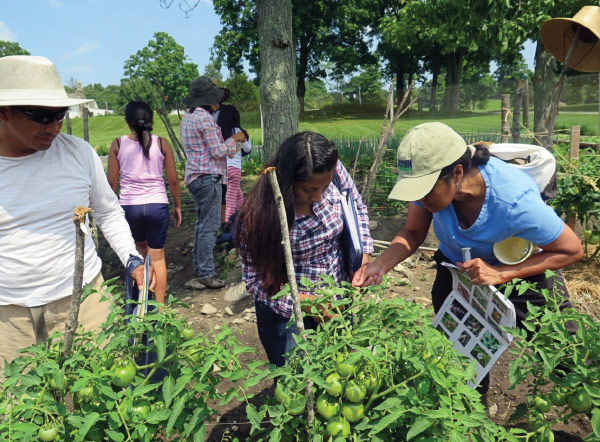Expression "New Entry Farmers" Includes Students, Too
 |
|
New entry farmers look for pests. Photo provided by Ana Legrand. |
It was the best-tasting radish I had ever eaten. I had just bitten, with gusto, into this perfect radish—crisp, juicy and pungent. It was given to me by one of the urban agriculture students just as we were getting ready for the farmer’s market. I appreciated the gift because I knew how hard they had been working on their “huerto,” growing these vegetables as part of the UConn Extension Urban Agriculture Program led by German Cutz. Through this program, students learn organic vegetable production and agricultural entrepreneurship.
Juan Guallpa, a student in the 2014 class, said, “We have learned to work as a team, to grow organic vegetables. We learned to cultivate vegetables the right way.”
This training is very much needed to address local food security needs and to provide income-generating opportunities for urban residents. Students joining this program have a strong interest in producing their own food but are also interested in the commercial or work opportunities they may find in the future. This is not a surprise. In most countries, urban agriculture is dominated by small producers achieving food security and income for their families (Smit et al. 2001).
While the benefits of urban agriculture range from the tangible produce to the social well-being aspects, there are challenges that need to be met. Urban agriculture systems have to be sustainable in every sense of the word. In this case, integrated pest management (IPM) practitioners contribute to the sustainability of these systems by applying knowledge of agroecosystem processes and by using environmentally-sound pest management solutions. Thus, with funding from a Northeastern IPM Center Partnership Grant, an Urban Ag and IPM training program was developed to foster IPM in urban ag systems. The objectives of the project were to promote the use of IPM with its lower-risk tactics, to increase locally-produced food to supply food desert areas in Connecticut and to engage Latinos living in urban cities in agribusiness opportunities.
For the most part, participating students had little or no agricultural experience. The program emphasized training in botany, vegetable production, entomology, crop risk management, and IPM. Instruction was provided in a bilingual format with classes taught in Spanish but also included English terms as well. At the end of the two-year project, twenty-one out of twenty-four students completed a year-round training that included 180 hours of classroom instruction, and the production and selling of over 7,000 pounds of organic vegetables through the Danbury’s Farmer’s Market. Each year, students produced more than ten different vegetables and herbs. With this diversity of crops they also learned about all of the different pest problems and IPM tactics available to them.
The program teaches IPM, including pest identification and the role of natural enemies. Pest monitoring was discussed and routinely practiced. On one weekend class, while the adult students reviewed scouting forms, the young students on their own initiative cleaned up all the flea beetles from eggplants using aspirators. Students learned about and employed biological, cultural, mechanical, and physical control tactics. They also used OMRI-approved pesticides when necessary. In all, it was a comprehensive exercise.
Students learned a wealth of IPM techniques—and 7,000 pounds of organic vegetables isn’t child’s play, either.
— Ana Legrand and German Cutz, University of Connecticut
Reference
Smit, J., J. Nasr, and A. Ratta. 2001. Urban agriculture: food, jobs and sustainable cities. Published by the Urban Agriculture Network, Inc. with permission from the United Nations Development Programme.
The Northeastern IPM Center promotes integrated pest management for reducing risks to human health and the environment. If republishing our news, please acknowledge the source (“From Northeast IPM Insights”) along with a link to our website.
